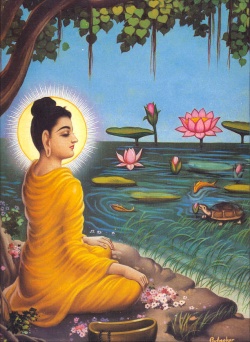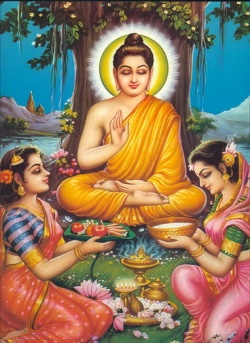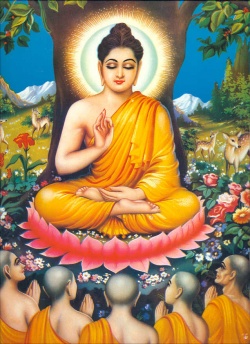Gohonzon
Gohonzon
[御本尊] ( Jpn)
The object of devotion. The word go is an honorific prefix, and honzon means object of fundamental respect or devotion. In Nichiren's (1222-1282) teaching, the object of devotion has two aspects: the object of devotion in terms of the Law and the object of devotion in terms of the Person. These may be described as follows: (1) The object of devotion in terms of the Law: Nichiren's mandala that embodies the eternal and intrinsic Law of Nam-myoho-renge-kyo. That Law is the source of all Buddhas and the seed of Buddhahood for all people. In other words, Nichiren identified Nam-myoho-renge-kyo as the ultimate Law permeating life and the universe, and embodied it in the form of a mandala.
In his Questions and Answers on the Object of Devo-tion, Nichiren refers to the object of devotion for people in the Latter Day of the Law as "the title (daimoku) of the Lotus Sutra." He further describes the title as the essence of the Lotus Sutra, or Nam-myoho-renge-kyo to be found only in the depths of the "Life Span" (sixteenth) chapter of the sutra. The Object of Devotion for Observing the Mind reads, "Myoho-renge-kyo appears in the center of the [treasure] tower with the Buddhas Shakyamuni and Many Treasures seated to the right and left, and, flanking them, the four bodhisattvas, followers of Shakyamuni, led by Superior Practices. Manjushri, Maitreya, and the other bodhisattvas, who are followers of the four bodhisattvas, are seated below" (366). In this passage, Nichiren clarifies the relationship between the Law of Nam-myoho-renge-kyo, the Buddhas Shakyamuni and Many Treasures, and the various bodhisattvas depicted on the Gohonzon. In this way he emphasizes Nam-myoho-renge-kyo as the fundamental object of devotion. The Real Aspect of the Gohonzon explains that all living beings of the Ten Worlds "display the dignified attributes that they inherently possess" (832) through the benefit of Nam-myoho-renge-kyo. Nichiren viewed the Dai-Gohonzon, the object of devotion he inscribed for all humanity on the twelfth day of the tenth month in 1279, as the purpose of his life.
This can be gleaned from his statement in On Persecutions Befalling the Sage, written in the tenth month of 1279: "The Buddha fulfilled the purpose of his advent in a little over forty years, the Great Teacher T'ient'ai took about thirty years, and the Great Teacher Dengyo, some twenty years. I have spoken repeatedly of the indescribable persecutions they suffered during those years. For me it took twenty-seven years, and the great persecutions I faced are well known to you all" (996). The object of devotion in terms of the Law is explained in greater detail in Nichiren's writings such as The Object of Devotion for Observing the Mind and The Real Aspect of the Gohonzon.
(2) The object of devotion in terms of the Person: In his Reply to Kyo'o, Nichiren writes, "I, Nichiren, have inscribed my life in sumi ink, so believe in the Gohonzon with your whole heart. The Buddha's will is the Lotus Sutra, but the soul of Nichiren is nothing other than Nam-myoho-renge-kyo" (412). Nichiren here expresses his realization of Nam-myoho-renge-kyo as the origin and basis of his life, which he embodied in sumi ink in the form of the mandala he calls the Gohonzon. In The Record of the Orally Transmitted Teachings, he says, "The object of devotion is thus the entity of the entire body of the votary of the Lotus Sutra." "The votary" here refers to Nichiren himself. He also says, "The Buddha of the Latter Day of the Law is an ordinary person and an ordinary priest." "An ordinary priest" here refers to Nichiren. Because Nichiren revealed and spread Nam-myoho-renge-kyo, which is manifest as the Person and the Law, he is regarded by his disciple and designated successor Nikkoand his followers as the Buddha of the Latter Day of the Law.
Nichiren himself writes in The Opening of the Eyes: "On the twelfth day of the ninth month of last year [1271], between the hours of the rat and the ox [11:00 P.M. to 3:00 A.M.], this person named Nichiren was beheaded. It is his soul that has come to this island of Sado and, in the second month of the following year, snowbound, is writing this to send to his close disciples" (269). He states that he "was beheaded," though actually he survived the execution at Tatsunokuchi, implying that the ordinary person Nichiren ceased to exist. In this context, the passage "It is his soul that has come to this island of Sado [his place of exile]" means that Nichiren described himself as having revealed a deeper, true identity in the course of his attempted execution. Again Nikkoand his followers equate that identity with the Buddha of the Latter Day of the Law.
(3) The oneness of the Person and the Law: This means that the object of devotion in terms of the Person and the object of devotion in terms of the Law are one in their essence. The Law is inseparable from the Person, and vice versa. The object of devotion in terms of the Law is the physical embodiment, as a mandala (the Gohonzon), of the eternal and intrinsic Law of Nam-myoho-renge-kyo. Nichiren writes in his Reply to Kyo'o, "I, Nichiren, have inscribed my life in sumi ink, so believe in the Gohonzon with your whole heart" (412).
This passage indicates that Nichiren embodied in the Gohonzon the state of life he enjoyed as the eternal Buddha who personified the Law, so that people could attain the same state of enlightenment. The Record of the Orally Transmitted Teachings reads: "The 'body that is freely received and used [also, the Buddha of limitless joy]' is none other than the principle of three thousand realms in a single moment of life. The Great Teacher Dengyosays: 'A single moment of life comprising the three thousand realms is itself the "body that is freely received and used"; this Buddha has forsaken august appearances. The Buddha who has forsaken august appearances is the Buddha eternally endowed with the three bodies.' Now Nichiren and his followers who chant Nam-myoho-renge-kyo are just this." "The Buddha who has forsaken august appearances" means a Buddha who is no different from an ordinary person in form and appearance.
(4) The core of the Three Great Secret Laws: The Gohonzon, or the object of devotion of the essential teaching, is the core of the Three Great Secret Laws in Nichiren's doctrine and represents the purpose of his life. The Three Great Secret Laws are the object of devotion of the essential teaching, the invocation, or daimoku, of the essential teaching, and the sanctuary of the essential teaching. Here, "essential teaching" refers to the teaching of Nam-myoho-renge-kyo, not to the essential teaching (latter half) of the Lotus Sutra. Nichiren expressed the Law of Nam-myoho-renge-kyo he realized within his own life in these three forms, which correspond to the three types of learning in Buddhism—precepts, meditation, and wisdom. The object of devotion corresponds to meditation, the invocation to wisdom, and the sanctuary to precepts. Sanctuary is a translation of the Japanese word kaidan, which is also translated as "ordination platform." This is a platform where practitioners vow to uphold the Buddhist precepts. In Nichiren's teaching, to embrace the object of devotion is the only precept, and the place where one enshrines the object of devotion and chants the daimoku is called the sanctuary. Again to keep faith in the object of devotion and chant the daimoku while teaching others to chant it is called the invocation. Both the sanctuary and the invocation derive from the object of devotion. Hence the object of devotion is the core of all three. For this reason the Gohonzon, or object of devotion, is also referred to as the One Great Secret Law.
(5) The inscriptions on the Gohonzon: In the center of the Go-honzon are written the Chinese characters "Nam-myoho-renge-kyo Nichiren." This indicates the oneness of the Person and the Law. On either side there are characters for the names of beings representing each of the Ten Worlds. At the top of the Gohonzon, the names of Shakyamuni Buddha and Many Treasures Buddha appear respectively to the immediate left and right (when facing the Gohonzon) of these central characters. They represent the realm or world of Buddhahood. The four bodhisattvas—Superior Practices, Boundless Practices, Pure Practices, and Firmly Established Practices—who lead the other Bodhisattvas of the Earth are positioned to the left and right of the two Buddhas. They, along with other bodhisattvas in the second row from the top such as Universal Worthy and Manjushri, represent the realm of bodhisattvas.
Also in the second row are persons of the two vehicles—voice-hearers and cause-awakened ones, such as Shariputra and Mahakashyapa—and flanking them are representatives of the realm of heavenly beings, such as Brahma, Shakra, the devil king of the sixth heaven, and the gods of the sun and moon. In the third row appear a wheel-turning king, representing the realm of human beings; an asura king, representing the realm of asuras; a dragon king, representing the realm of animals; the Mother of Demon Children and the ten demon daughters, representing the realm of hungry spirits; and Devadatta, representing the realm of hell. Moreover, the four heavenly kings are positioned in the four corners of the Gohonzon: (again, when facing the Gohonzon) Vaishravana in the upper left, Upholder of the Nation in the upper right, Wide-Eyed in the lower right, and Increase and Growth in the lower left. While all other figures on the Gohonzon are represented in Chinese characters, the names of the wisdom king Craving-Filled and the wisdom king Immovable are written below Vaishravana and Upholder of the Nation respectively in Siddham, a medieval Sanskrit script. Here the wisdom king Craving-Filled represents the principle that earthly desires are enlightenment, and the wisdom king Immovable, the principle that the sufferings of birth and death are nirvana. Other characters on the Gohonzon include the names of Great Bodhisattva Hachiman and the Sun Goddess.
All these names express the principles that the Ten Worlds exist within the eternal Buddha's life, and that living beings of the Ten Worlds can attain Buddhahood. Not all of the above names appear on every Gohonzon that is transcribed from the Dai-Gohonzon, but whichever ones do appear represent all of the Ten Worlds.The names of the Great Teacher T'ient'ai and the Great Teacher Dengyoare inscribed in the lower part of the Gohonzon representing those who transmitted the true lineage of Buddhism. There are two inscriptions gleaned from Miao-lo's Annotations on "The Words and Phrases of the Lotus Sutra," which Nichiren used to describe the power of the Gohonzon and the Law it embodies. One, placed in the upper right (facing the Gohonzon), reads, "Those who vex or trouble [the practitioners of the Law] will have their heads split into seven pieces." The other, in the upper left, reads, "Those who give alms [to them] will enjoy good fortune surpassing the ten honorable titles." The ten honorable titles are epithets applied to the Buddha expressing his virtue, wisdom, and compassion. In the lower right is Nichiren's declaration that "This is the great mandala never before known in the entire land of Jambudvipa in the more than 2,230 years since the Buddha's passing.


